Garden Therapy Column – April 2017
It is déjà vu all over again. Last month when I sat down to write my column, the winds were howling, the snow was blowing and there was about 14 inches of snow on the ground. Since then the snow subsided, we had some nice weather and I even made motions toward starting my spring gardening tasks. However as I sit to write this, there is a repeat performance of the wind howling and there is about 30 inches of accumulation. We are thoroughly snowed in, waiting for Bill Drew to come rescue us.
I am actually grateful for “a real winter” and to have some time to finish getting ready for the spring mayhem. There is plenty of design work to do and recently my projects seem to progressively involve tough and steep hills. Dealing with grade changes is always a challenge but the bigger the grade, the harder it is. Slopes are offer great opportunities to do cool stuff but depending on the angle and length of the slope, an attractive, maintainable solution can get very dramatic and very expensive (!).
There are several challenges with slopes: it is often hard to get up and down them and it is can be tough to get stuff to grow on them. Flat areas are much more convenient (plants and soil don’t slide away) but not every landscape has this luxury. While hanging out with friends for cocktails is not going to be a “slope-friendly” activity, there are a few basic options for making your slopes more useful and attractive. This includes, decks, retaining walls, terracing, steps and ramps, grading and planting.
As a landscape designer I am usually not involved in the big picture grading plan for a property, which involves creating a site for the house and yard area as well as laying out a functional driveway. That part is usually a large undertaking and deftly handled by the likes of excavating professionals like the LaFevers. But bad things can happen when the pros are not consulted at the beginning.
When we purchased our property the driveway went straight up the hill at more than a 20 degree grade and there was a very steep slope right in front of the house. Not very attractive and not very functional! There was almost no flat area for a garden except right over the septic and leach field. We needed to bring in a pro and LeFever came to the rescue. First order of business was an accessible driveway and we also wanted a good-sized flat area for a nice ornamental garden with small trees, shrubs and perennials.
This was no easy task. The elevation changes about 75 feet from the road to our garage door and the slope right in front of the house was particularly steep. Jonathan LaFever figured out a smart plan. He had to use the entire width of our property to be able to carve out a workable driveway. He taught me that a driveway should only have a 10 to 12% grade on the rises and 5% on the curves. We ended up with a double ‘S’ driveway that touches our property line 3 times in order to accomplish this.
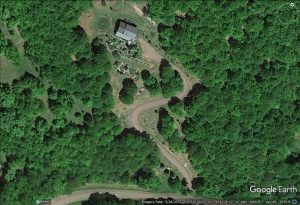
The house has a frontier porch spanning the front of the house taking full advantage of the mountain views so it made sense to have the garden in the front where we could sit and enjoy the backdrop panorama and the garden. This required building a pretty massive retaining wall to create a relatively level space. And this is where my romance with boulders began. The retaining wall that LeFever installed was all boulders. You could feel the earth shake when they off-loaded them! The boulder wall ended up about 5 feet tall and created about 35 feet of space between the house and the wall. It is about 130 feet long and has 2 sets of natural boulders steps to get down to the next level. The “before and after” photos below show how this worked.
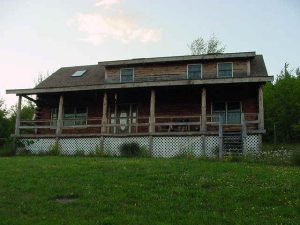
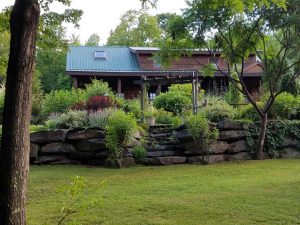
Tall walls are not my preference, if they can be avoided. While they can be very dramatic, they also can be dangerous. Tall walls should have a good sized bed or fence/railing to deter folks (or vehicles) from going over the edge. I try to design around the need for height by using terraces and landings with interesting transitions. However, that is just not always possible. In the house pictured below, I was not involved with the big picture of the setting this house and driveway. This was a Duane LaFever job and the scope of this undertaking and walls is quite amazing. I came in later and created the patio, paths and steps which I will talk about next month.
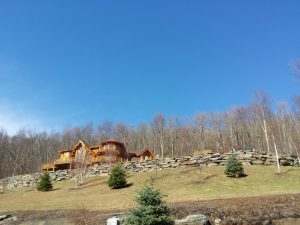
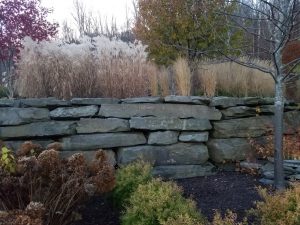
Another of my slope challenges last year involved quite a bit of hill hacking to create a series of terraces and steps (pictured below). The design resulted in an interesting and inviting treatment to connect a parking court with the entrance to “the office” on the lower level. I am really looking forward to seeing the plants grow in as this photo was taken immediately after the installation.

To be continued …

Thank you for a very professional presentation, well worth watching. You do such a great job explaining and have a great voice.
https://www.elitehorticulture.com/
Cammy Massimo - April 1, 2017Thank you Cammy. I enjoy writing and trying to make it real.
Mel Bellar - April 1, 2017